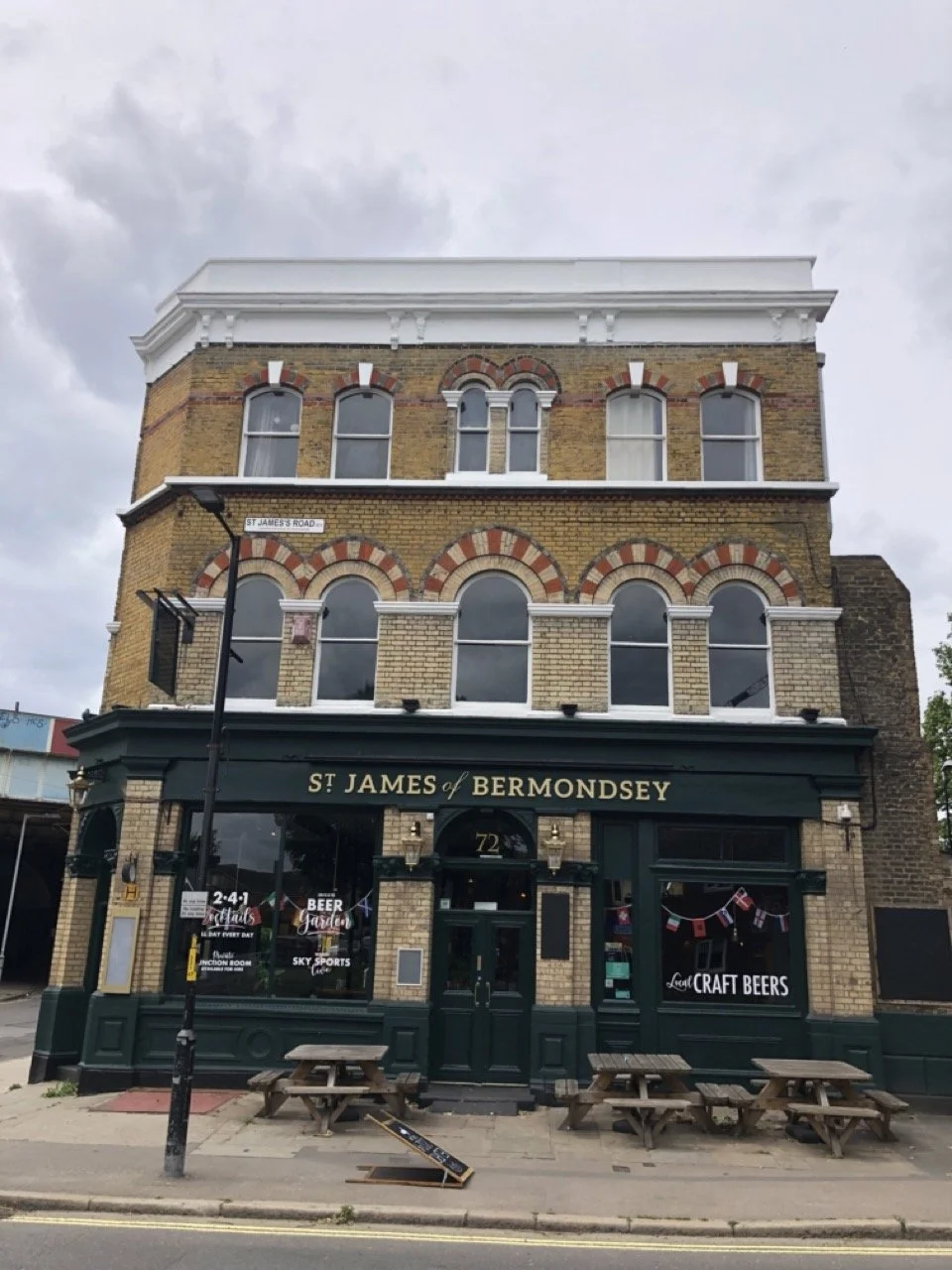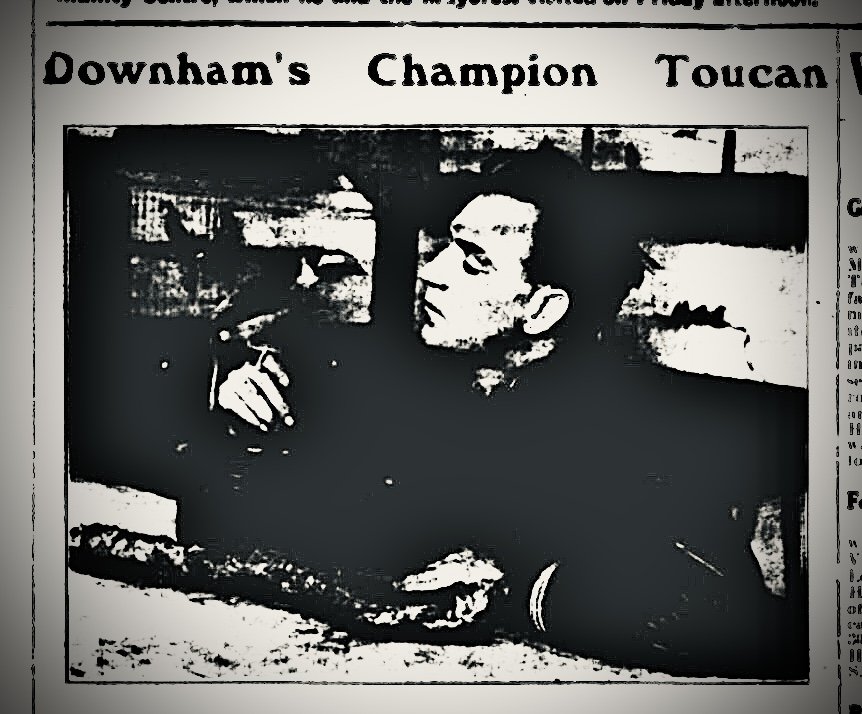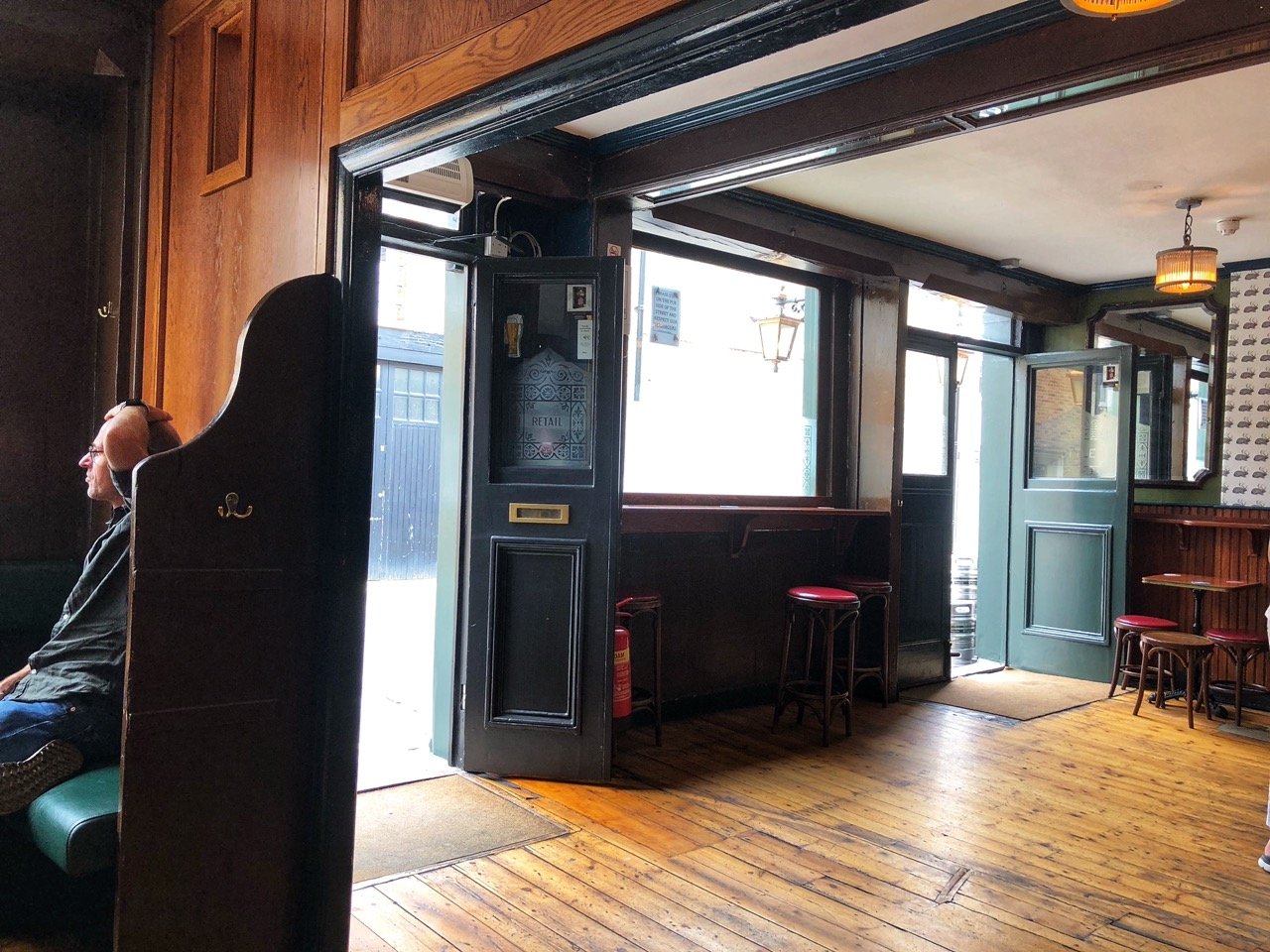June: Bermondsey Blues, Churchillian Chat and Pub-Hopping in the 1940s
A monthly newsletter about London beer and pubs written by Will Hawkes
Enjoy London Beer City? Support it here
Untied
4 July is Independence Day across the Atlantic, a jamboree (so I’m led to believe) of meat-grillin’, star-spangled caterwaulin’ and random whoopin’. This year, though, our American cousins are not going to have the fun to themselves: there’ll be a degree of joy in Bermondsey, too, albeit in a more restrained form.
On that day, Anspach and Hobday’s six-month lease of the St James of Bermondsey pub runs out, and - as co-owner Jack Hobday puts it, albeit in not so many words - not a moment too soon.
That might seem odd, on the face of it. It’s a nice pub in a lively area, cheek-by-jowl with some of London's most important food companies, from Natoora to Neal’s Yard and The Kernel. It’s well-decorated - tastefully pastel - with a variety of seating options and all the sports TV you could ever want.
But, as so often with British pubs, the devil is in the detail. The St James is owned by Stonegate, Britain’s biggest pub group, and if A&H wanted to keep the pub going, they’d have had to accept a five-year deal at 90 percent of the advertised £49,972 a year, with no break, although they’d only be paying 60 per cent for the first two years (they’re currently paying a third).
For many pubs that would be a great deal, but the St James is not doing great business. According to Jack, it makes a little bit more than £6000 net a week - less than their nearby railway arch, which has very limited opening hours, and well below Stonegate’s forecast of £11,845 pw. Thanks to their initial deal with Stonegate, they’re not losing money, but after July 4 they would be.
So why take it on in the first place? After all, the pitfalls of dealing with some pubcos are not unknown. “We wanted to have a pub in Bermondsey which sold some local beer, with A&H being at the forefront,” says Jack. “But the beer we’ve been able to offer is not what we thought we’d be able to offer: in terms of small breweries, we can only use them on cask.”
Stonegate (which reportedly has debt of £2.2bn) uses The Beer Company for its procurement, but the range of keg beer A&H have been able to get has been limited to big-brewery brands, according to Jack, who had wanted to offer Budvar before it was delisted because it wasn’t popular enough. “[Our options were limited to] the latest Spanish lagers mixed with Carlsberg, Carling, Heineken and their sub-craft brands like Camden, Beavertown or Brixton, plus a handful of others,” he says. “Some of the beers are fine but it’s not what we’re about.”
And then there’s the prices. Guinness can be bought by London publicans for anything from about £110 to £190 for a 50-litre keg at the moment, depending on who’s selling and who’s buying, but A&H were quoted £210 for the St James.
A&H was able to sell its own beer to the pub only on cask, but even then it was a painful experience. They sell their own beer into Stonegate at around £70 a firkin (72 pints, in theory), but the pub buys it at £130 or £140 a go. “We even have to deliver the beer direct as part of that sale!” says Jack.
It’s been a chastening experience, all told, but Jack says there are elements that have been enjoyable. “The community element has been great,” he says. “We’ve had post-natal classes in our function room, we’ve got our quiz, and the pub is still popular with Millwall fans on match days. And we saved it from being closed, which I’m very pleased about. And it’s been profitable for us - but it wouldn’t be with the new rent.”
So would they consider doing it again, with a different pub? “I think we’ve shown we can do it - our team, led by Simon Courtney, has been brilliant,” he says. “We’ll have another go, but it’d probably have to be a free-of-tie option. You’ve got to have a good location with good facilities, and they’re hard to find. We won’t rush into anything, but it’s definitely on the radar.”
………………………
Man’s Drink
Do women drink beer? Not very much, if the results of a poll commissioned by Dea Latis and presented at Five Points’ brewery in Hackney last month are to be believed. Only 14 percent of women drink beer each week (compared to 50 percent of men), a three percent drop since the group’s first report back in 2018.
The report suggests that there are a number of key barriers, including the notion that beer is highly calorific with negative health implications, and the way it is presented and served. Apparently London, where “traditional views” around beer are being challenged, is the one bright spot.
I don’t have a great deal to offer in terms of insight on this - for obvious reasons - but I do find it fascinating that beer appears to be less popular amongst British women than it is in comparable European nations. Why should that be?
………………………
Churchillian Chat
Gerry O’Brien is perhaps London’s most well-known landlord, having transformed the Churchill Arms in Notting Hill into one of the city’s most famous pubs. He’s spoken to Elton Mouna, ex-Remarkable Pubs MD, about his time running the pub for a new podcast, ‘From Ordinary to Extraordinary’. Find it here on Spotify and here on Apple.
………………………
Tavern Tales: ‘The Tavern Where You Needn’t Drink’
This is the second part of a series about the Downham Tavern, once Britain's biggest pub, now mostly a Co-op.
Datas, the Memory Man, legend of London music hall and inspiration for the character Mr Memory in Alfred Hitchcock’s The 39 Steps, is on stage at the Downham Tavern. Outside it’s a stormy Friday night, August 1931, but inside the hall is packed, a record attendance, dozens locked out. Three hours of entertainment featuring many of music hall’s greatest names, from Tom Costello to Jock Whiteford, ‘The Smart Scot’, await - but the Memory Man is first.
Datas is as keenly anticipated as any of his co-stars, because he knows, or seems to know, everything. Derby winners are his speciality, in an era when the Derby still meant something. He reels off a list of winners in response to a question from the crowd, ending with his catchphrase: “Am I right, sir?”
He does jokes, too. “What was Adam and Eve’s Telephone Number?” “281 Apple,” Datas - real name William James Maurice Bottle - replies, to cackles of laughter.
He even tells a few disbelieving punters the date of their birth. How does he do it?
But not everyone is convinced. An Irishman pipes up, demanding to know the date of a battle in Ireland. He’s not happy with Datas’s answer, and advances to the footlights to remonstrate, before being convinced to let it go.
Among the crowd is Daily Herald journalist Hannen Swaffer, who tracks down landlord Fred Johnson. “That Irishman’s a stranger,” he insists. “He doesn’t come from around here. The Downham people all behave themselves.”
Swaffer (above; according to the British Journalism Review, he was remembered after his death for “little more than the mixture of dandruff and cigarette ash on his velvet collar”) is much taken with the show. He likes the acts. He likes the crowd. He likes the notion that a music-hall revival might be on the cards, even if its real glory days are a few decades in the past.
What Swaffer, boozer-turned-teetotaler, really likes though is the attitude to alcohol. “Alcohol is dying out naturally,” he tells his Daily Herald readers. “Drinking is not encouraged,” he quotes Mrs Johnson. “My husband often goes onto the stage when the show is on and tells the audience they need not buy any alcohol. ‘I am not asking you here to buy drink,’ he says.”
In the 1930s, entertainment at the Downham Tavern was a sanitised version of the recent past, a reflection, perhaps, of Britain’s own refusal to face the future. There were dances for old folk, shows for kids, regular meetings of the Old Contemptibles, an organisation for First World War veterans. Music hall might have been born amid the booze and sleaze of late Victorian London, but by the time it reached Downham it had been comprehensively scrubbed. Like the residents, it had apparently thrown off its urban past.
But in a world of cinemas and recorded music, it was on its way out, however you presented it. When Frank Johnson (also a noted parrot fancier) and his wife, both brought up in the Music-hall world, retired in 1938, an era ended. Music hall made a swift exit, following table service, ditched the previous year.
But what would follow? That night in 1931, Johnson had told Swaffer that - unlike that uncouth Irishman - his regulars were good as gold. “In fifteen months we have never had one case of rowdyism,” he said. “Family parties come here and they are all as quiet as lambs.” Even if it were true then, it wouldn’t be for long.
………………………
Tenth Life
Catford’s biggest boozer, the former Black Horse and Harrow, has re-opened as the Duke of Catford. It was until recently Ninth Life. Good luck to the new owners - given the huge size and the way it’s changed hands at regular intervals over the past decade, they’ll probably need it. Plus points: the food looks promising and it’s open until 1am on Friday and Saturday.
………………………
Just Deserts
South London’s premier pub-going partnership, Deserter, will be celebrating its tenth birthday on Saturday with an event at the pub they co-own, The Shirker’s Rest in New Cross. Ned Boulting of cycling fame will be firing questions at the pair - authors of Today South London, Tomorrow South London and Shirk, Rest and Play - and there’ll be some free beer. It all kicks off at 5pm.
………………………
Two Pubs, One City
The Spread Eagle, W1C & The Jackalope, W1G
“London still has most of its 4,000 pubs, and they still number amongst them pubs of every kind. Old, sham-old, and comparatively new; prosperous and neglected, smart and shabby; pubs standing forlornly in the midst of bomb-damage, with their top storey missing and one bar gone, and pubs lurking safely under the great piles of modern office blocks.”
When Maurice Gorham wrote this in Back to the Local, London was recovering from a catastrophic war. Now, with London on the brink of recovery from a catastrophic government (zing! Another crushing blow for Sunak), you could make much the same claim - excepting, I will grudgingly admit, the bomb damage. We’ve even got about the same number of pubs: 3600, on the most reliable recent evidence I can find (although there were 5000+ 20 years’ ago).
Gorham’s book, long considered a classic of the genre, was republished last week. It’s a handsome edition, with original illustrations by Edward Ardizzone that evoke pure cosiness and a handy fold-out map at the front featuring those pubs that are still operating. (The pub index at the back is the original one, so it doesn’t quite tally with the map, but let’s not quibble).
A delightful read, no doubt, full of enticing detail and Forties charm - but given the map, it’s clearly intended to act as a modern-day guide too. Who could resist? Not me, which is how I found myself weaving between disorientated tourists and American Candy fans just after Thursday lunchtime last week, en route to The Spread Eagle south of Oxford Street on Woodstock Street.
It’s immediately obvious something has changed since Gorham’s day. Even an architectural ignoramus like me can tell this is a fifties/sixties building, with the Spread Eagle tucked into a tight nook at ground level, seating in front. Apparently Gorham’s Spread Eagle was on Oxford Street; well, now it’s not. In fact there aren’t any pubs on Oxford Street west of The Flying Horse, once The Tottenham, right up by Tottenham Court Road station.
One of the great attractions of the Spread Eagle, Gorham wrote, was “the two dizzy blondes [who] both sprang forward to serve you as soon as you opened the door”, which is a nice bit of period colour, ahem, but obviously I condemn that sort of thing in no uncertain terms. Nowadays the bar is staffed by a middle-aged man and a young woman, and there’s no springing - although service is comfortably the right side of competent.
This is a Greene King pub, so I’m well-pleased to spot Black Sheep Bitter (bitter, a touch tangy, a bit Shepherd Neame-y; £6.10), which I take to a seat in the back. It’s a surprisingly small pub, cosy, albeit there’s apparently more room upstairs. The front bar opens out a little into the library-like back room, but you could still get 20 of these in an average Spoons.
A Spanish-speaking couple are at a nearby table, soaking up a bit of English pub culture: she with a glass of Coke, he with regularly replenished pints of Camden Hells. I’m glad to see they’ve ordered lunch, since Gorham mentions approvingly the restaurant that was part of the original boozer. Fish and chips for her (£17.45), pie and chips (£15.25) for him, which is a pretty 1949-adjacent order even if the prices have gone up a bit.
“Gracias,” the barman says as he puts their food down, a nice touch although I think traditionally they should be thanking him.
There’s an interesting mixed vibe going on here. On one hand, it’s relaxed. Gentle house music fills the room, golf is on the telly (Never ends, golf, does it? Like tennis. There’s always a tournament on somewhere, it’s always boring, and the winner gets eleventy billion dollars) and the clientele is a subdued mix of tourists and office staff.On the other hand, the barman - a no-nonsense scouser - has to chase some kids out of the pub for a reason I can’t ascertain because I can’t quite see what’s going on. There’s plenty of shouting before he wins the day and returns to the bar triumphantly.
I quite like this pub, given the circs, but it doesn’t really evoke Gorham’s book, not least because it wasn’t built when he wrote it. Happily, a far more sympathetic scene awaits me 10 minutes’ walk north through Marylebone (Fancy car count: three Porsches, which isn’t that impressive. I saw a Lamborghini in SE4 the other day. Raise your game, Marylebone, Mayfair is laughing).
The Jackalope may have changed its name (from The Dover Castle), but in all other ways it’s a period-drenched delight. The bar, a bowed wooden effort, is original. There are three rooms, albeit one of them has been opened up a bit. The front windows still say ‘Dover Castle’. The barman is a genial Irishman. The cask ale is sadly sparkled, but good value, and from London: Redemption Trinity, £4.60.
Even the clientele impresses. In the corner there’s a woman with her mum and gurgling new-born baby: grandma buys mum a pint of Adnams and a cider for herself. Three middle-aged men chat comedy. A group of office pals spill out into the Mews after lunchtime pints, promising to do it again. A man in a grey suit buys a pint of Bitburger. There’s eclectic, reasonable-level music, from Black Betty to a Rolling Stones cut so deep (We Had It All) Keith Richards has probably forgotten recording it.
In the book, Gorham as near as says this is his favourite pub, and ‘Mooney’, who ran it then, his favourite landlady. “One of the most friendly resorts in the West End … old-fashioned but bright … gives a lot of pleasure.” I’d say that’s all still true. It’s the sort of pub where, as soon as you’ve left, you want to go back (and that’s before you mention LIU Xiaomian, the noodle restaurant downstairs).
There’s a touch of magic about this place. Just as I’m finishing up my pint, the barman comes round to write names on the tables booked for that evening. I can hardly believe my eyes when I see what, in neat block capitals, he puts on mine: M Gorham?!
Sadly no - this is just banter. It’s H Smith, and he’s bringing 12 of his pals at 6.30pm. I bet they have a great time, as would Gorham if he could pop in today. Few pubs in the West End - even in London - evoke the sense of timeless pleasure you get on a warm afternoon at the Jackalope, with the doors wide open and the noise of the city a Mews-length away.
………………………
London Beer City is written by journalist Will Hawkes. Feel free to contact me on londonbeercity@gmail.com. If you like what you’ve read, please share it with your friends; if you’ve been forwarded this email and enjoyed it, you can sign up here. Unsubscribe here. Help me keep the newsletter free here. Thanks for reading!












